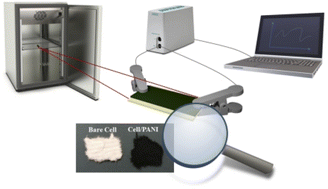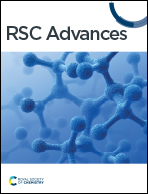A resistive sensor for humidity detection based on cellulose/polyaniline†
Abstract
Ambient humidity is an important parameter that affects the manufacturing and storage of several industrial and agricultural goods. In the view of the Internet of Things (IoT), single sensors could be associated with an object for smart monitoring enabling optimum conditions to be maintained. Nevertheless, the production of cost-effective humidity sensors for indoor and outdoor environmental monitoring currently represents the main bottleneck in the development of this technology. Herein we report the results obtained with sensors exclusively made of cellulose and polyaniline (cell/PANI) under strictly controlled relative humidity (30–50 RH%) and temperature (21 ± 1 °C) achieved with a climatic chamber that simulates the conditions of indoor air humidity, and at different RH% in a lab test chamber set-up. Cell/PANI sensors, prepared with a simple, inexpensive, and easily scalable industrial paper process, show a linear trend with a slope of 1.41 μA RH%−1 and a percentage of sensitivity of 13%. Response time as well as percentage of sensitivity results are similar to those of a commercial digital-output relative humidity and temperature sensor (DHT22) employed in parallel for comparison. The commercial sensor DHT22 has a sensitivity of 14%. This low-cost sensor has potential applications in agriculture, food monitoring, and medical and industrial environments as a disposable sensor for humidity detection.



 Please wait while we load your content...
Please wait while we load your content...